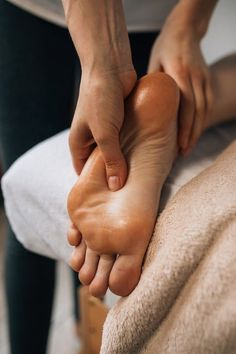Introduction to Reflexology: A Beginner's Guide to Healing through Touch
## Introduction to Reflexology: A Beginner's Guide to Healing through Touch
Reflexology is an ancient therapeutic practice that focuses on applying pressure to specific points on the feet, hands, and ears, believed to correspond to various organs and systems within the body. This gentle, non-invasive therapy aims to promote relaxation, relieve stress, and enhance overall well-being.
### What is Reflexology?
Reflexology operates on the premise that certain areas of the body are linked to specific reflex points. By applying pressure to these points, reflexologists aim to stimulate the body's natural healing processes. This practice is often referred to as **zone therapy**, as it divides the body into zones that correspond with different areas of the feet and hands[1][5].
### How Does Reflexology Work?
The mechanisms behind reflexology are rooted in several theories:
- **Zone Theory**: The body is divided into ten vertical zones that align with specific fingers and toes. Stimulating these areas can impact the corresponding body parts[2].
- **Nervous System Stimulation**: Pressure applied to reflex points may activate the nervous system, promoting relaxation and improving blood flow, which can alleviate pain and discomfort[1][2].
- **Qi Flow**: In traditional Chinese medicine, reflexology is believed to help balance the flow of **qi** (vital energy) throughout the body. Blockages in qi can lead to physical and emotional issues, and reflexology aims to restore this balance[2].
### Benefits of Reflexology
While reflexology is not a substitute for medical treatment, many people report various benefits from regular sessions:
- **Stress Reduction**: Reflexology can significantly lower stress levels and promote relaxation[1][3].
- **Pain Relief**: Some studies suggest it may help alleviate pain associated with conditions like arthritis, migraines, and menstrual discomfort[2][3].
- **Improved Mood**: Many individuals experience enhanced emotional well-being after sessions, which can also aid in managing anxiety and depression[2][4].
- **Enhanced Energy Levels**: Clients often report increased energy and reduced fatigue following treatment[3].
### What to Expect During a Session
A typical reflexology session lasts between 30 to 60 minutes. The practitioner will usually begin by applying a soothing oil or cream on your feet. They will then use their thumbs, fingers, or knuckles to apply varying degrees of pressure on specific reflex points. Many clients find the experience deeply relaxing, sometimes even falling asleep during treatment[1][3].
### Conclusion
Reflexology offers a holistic approach to health that emphasizes the connection between touch and healing. While more research is needed to fully understand its efficacy for specific conditions, many individuals find value in incorporating reflexology into their wellness routines. As with any complementary therapy, it is essential to consult with healthcare professionals before starting any new treatment regimen.
Citations:
[1] https://www.webmd.com/balance/what-is-reflexology
[2] https://www.healthline.com/health/what-is-reflexology
[3] https://marfan.org/blog/improving-your-quality-of-life-an-introduction-to-reflexology/
[4] https://www.jodiepurcelltherapies.com/post/an-introduction-to-reflexology
[5] https://www.bestmassage.com/article-introduction-to-reflexology
[6] https://www.cosycottagesoap.co.uk/blogs/news/an-introduction-to-reflexology
[7] https://www.sciencedirect.com/topics/nursing-and-health-professions/reflexology
[8] https://www.medindia.net/alternativemedicine/reflexology/reflexology.htm


Comments
Post a Comment